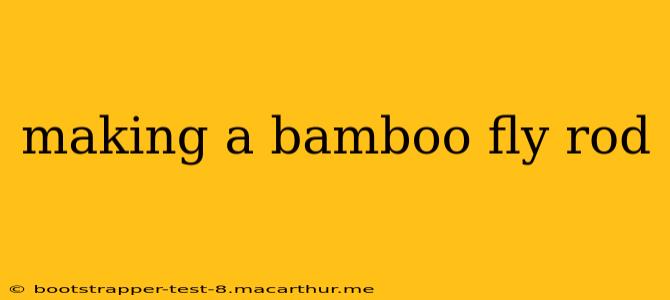Making a Bamboo Fly Rod: A Comprehensive Guide for the Aspiring Rod Builder
Crafting a bamboo fly rod is a rewarding journey, blending artistry, craftsmanship, and a deep connection to fly fishing history. This process requires patience, precision, and a willingness to learn, but the result—a unique, handcrafted rod—is unparalleled. This guide delves into the essential steps involved, answering common questions along the way.
What Tools and Materials Do I Need to Make a Bamboo Fly Rod?
Building a bamboo fly rod requires specific tools and materials. You'll need high-quality bamboo culms (strips) of the correct dimensions for your chosen rod length and action, a rod-making jig or form, various clamps and vises, specialized planing tools (spokeshaves, etc.), sandpaper of varying grits, a heat source for curing the glue, varnish or finish, and various other small tools like files, measuring tools, and a sharp knife. Finding a reputable supplier for your bamboo is crucial, as the quality of the culms significantly impacts the final rod. Many specialized suppliers exist, both online and offline, catering specifically to rod builders.
What Are the Steps Involved in Making a Bamboo Fly Rod?
The process can be broken down into several key stages:
-
Bamboo Selection and Preparation: Carefully select your bamboo culms, ensuring they are straight, free from flaws, and possess the desired properties for your rod's action. This often involves meticulously examining each culm and potentially rejecting many before finding suitable ones. This stage demands a keen eye and significant experience.
-
Planing and Shaping: This is where precision is paramount. Using specialized tools, you'll carefully plane each bamboo strip to the precise dimensions required for your rod's design, achieving uniform thickness and taper. This is an iterative process, requiring continuous checking and adjustment to meet the specifications.
-
Assembly and Gluing: The carefully planed strips are then assembled, aligned, and glued together using a strong, heat-activated adhesive. This step involves clamping the strips tightly in place on a rod-making jig, ensuring a perfect alignment to prevent warping and imperfections. The glue must be meticulously applied to guarantee a durable and seamless bond between the strips.
-
Curing and Drying: Once glued, the rod blank is allowed to cure and dry completely according to the adhesive manufacturer's instructions. This process ensures the glue properly sets and prevents any issues with the rod's integrity during subsequent stages.
-
Finishing and Refinement: After curing, any excess glue is removed. The blank is then sanded to a smooth finish, using progressively finer grits of sandpaper. This step requires patience and attention to detail. Finally, a protective varnish or finish is applied to preserve the rod and enhance its aesthetics.
-
Finishing Touches: Once the finish is fully cured, the rod is fitted with ferrules, guides, reel seat, and grip. This requires precision work, ensuring all components are securely fastened and aligned perfectly.
How Much Does it Cost to Make a Bamboo Fly Rod?
The cost varies considerably depending on the quality of bamboo used, the tools you own (or need to purchase), and the amount of time invested. Expect to invest a significant amount of money, and even more importantly, time. The cost of materials alone can be substantial, especially for higher-grade bamboo.
How Long Does it Take to Make a Bamboo Fly Rod?
The time required depends on your skill level and the complexity of the rod design. Expect to spend many hours, potentially weeks or even months, depending on your experience and the complexity of the rod. Beginners should plan for a substantial time commitment.
What are the Different Types of Bamboo Used for Fly Rods?
Various bamboo species are used in fly rod construction, each possessing unique properties. Tonkin cane, from Southeast Asia, is a popular choice due to its strength and flexibility. Other species are also used, each influencing the rod's action and overall performance. The choice of bamboo often depends on the builder's preference and the intended fishing style.
Making a bamboo fly rod is a challenging but incredibly rewarding endeavor. The time and effort invested are handsomely repaid by the pride of owning a truly unique and exceptional fly rod. Remember to prioritize safety and always follow appropriate safety guidelines when working with tools and adhesives.
